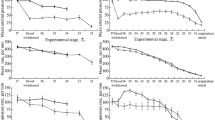Summary
Extreme cold has been focally applied to major extracranial arteries and veins in the cat. Reversible slowing of circulation and vascular occlusion have been shown to occur from this application. Following rewarming no acute changes within the lumen of the blood vessels have been observed radiographically and permanent thrombosis does not result after freezing of segments up to 30 minutes. Possible uses for this modality in cerebrovascular surgery are discussed.
Zusammenfassung
In Versuchen an Katzen wurden die Folgen umschriebener Einwirkung extremer Kälte auf extrakranielle Arterien und Venen untersucht. Es konnten damit reversible Zirkulationsverlangsamungen und reversible Gefäßverschlüsse hervorgerufen werden, bedingt durch ein Zufrieren der Gefäße. Nach dem Wiedererwärmen konnten angiographisch keine akuten Veränderungen des Lumens der Gefäße nachgewiesen werden. Es kam, selbst nach Einfrieren von Gefäßsegmenten bis zu 30 Minuten, nicht zu bleibenden Thrombosen. Die eventuellen Anwendungsmöglichkeiten dieses Verfahrens in der zerebralen Gefäßchirurgie werden diskutiert.
Résumé
Le froid intense a été appliqué focalment aux artères et aux veines principales extracraniennes du chat. On a montré que le ralentissement réversible de la circulation et l'occlusion vasculaire se produisent à la suite de cette application. Pendant le réchauffement qui suit, aucun changement important n'est observé radiographiquement dans le calibre des vaisseaux sanguins et il ne se produit pas de thrombose permanente résultant du refroidissement des segments jusqu'à 30 minutes. On discute des usages possibles de cette technique en chirurgie cérébrovasculaire.
Riassunto
Il freddo spinto è stato applicato localmente alle principali arterie e vene nel gatto. Dopo questa applicazione è stato notato un rallantamento reversibile della circolazione sanguigna ed una occlusione vascolare.
Dopo il riscaldamento non sono stati osservati radiologicamente cambiamenti acuti entro il lume dei vasi nè trombosi permanenti dopo aver raffreddato i vasi sino a 30 minuti. Le possibili applicazioni di questa metodica alla chirurgia cerebrovascolare sono discusse.
Resumen
El frio intenso ha sido aplicado localmente sobre las principales arterias y venas extracraneales del gato. Se ha demostrado que después de esta aplicación de frio se produce una lentificación reversible de la circulación y oclusión vascular. Posteriormente durante el recalentiamiento no se ha observado ningún cambio importante visible radiográficamente en el calibre de los vasos sanguineos y no se produjeron trombosis permanentes a consecuencia del enfriamiento de segmentos llegando hasta 30 minutos. Se discuten las posibles aplicaciones de esta técnica en cirugia cerebro-vascular.
Similar content being viewed by others
Bibliography
Coe, J. E., andA. K. Ommaya, Evaluation of focal lesions of the C. N. S. produced by extreme cold. J. Neurosurg., Springfield,21 (1964), 433–455.
Cooper, I. S., A cryogenic method for physiologic inhibition and production of lesions in the brain. J. Neurosurg., Springfield,19 (1962), 853–858.
Dohn, D.F., Transsphenoidal stereotaxis hypophysectomy in the treatment of cancer and endocrine disorders. Paper read at 32nd Annual Meeting Harvey Gushing Society, Los Angeles. April 20–22, 1964.
Ommaya, A. K., andM. Baldwin, Direct extravascular brain cooling i nthe normothermic animal. J. Neurol., London,12 (1962), 882–895.
Ries, L., andJ. S. Tytus, Rapid freezing, a surgical technique. Bull. Mason Clin., Seattle,14 (1960), 20–26.
Rockoff, S. D., andA. K. Ommaya, Experimental Head Trauma. Cerebral angiographic observations in the early post-traumatic period. Amer. J. Roent., Radium Therapy and Nuclear Medicine XCI No. 5 (1964), 1026–1035.
Rowbotham, G. F., A. L. Haigh, andW. G. Leslie, Cooling canulla for use in treatment of cerebral neoplasm. Lancet, London, 1: 7062 (1959), 12–15.
Author information
Authors and Affiliations
Rights and permissions
About this article
Cite this article
Coe, J.E., Rockoff, S.D. & Ommaya, A.K. The effects of extreme cold on major extracranial arteries and veins. Acta neurochir 12, 778–790 (1965). https://doi.org/10.1007/BF01404625
Issue Date:
DOI: https://doi.org/10.1007/BF01404625




